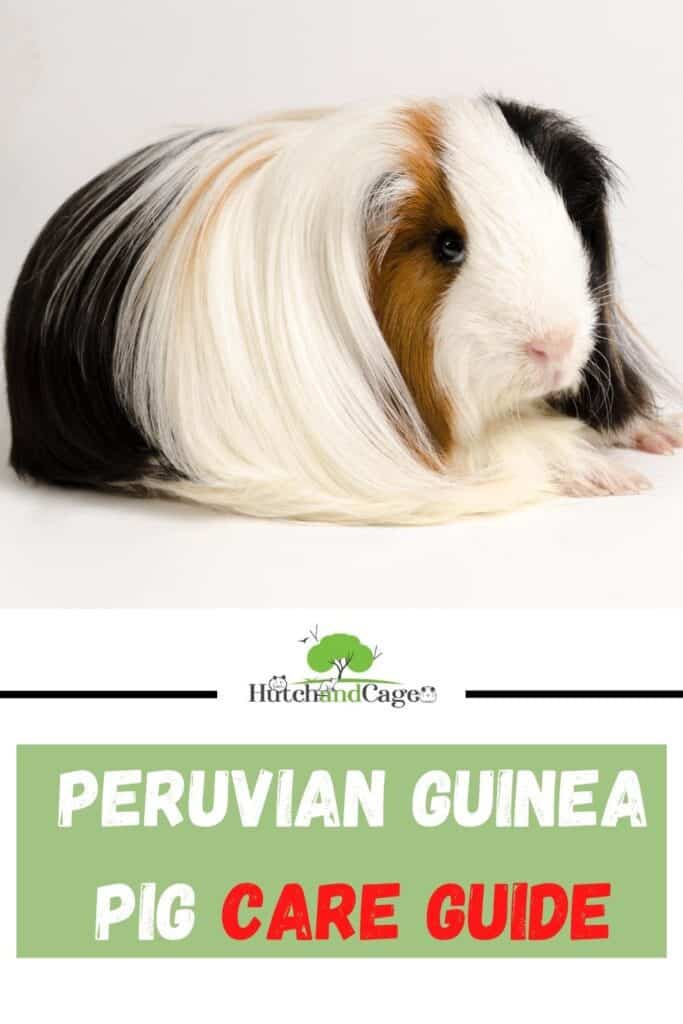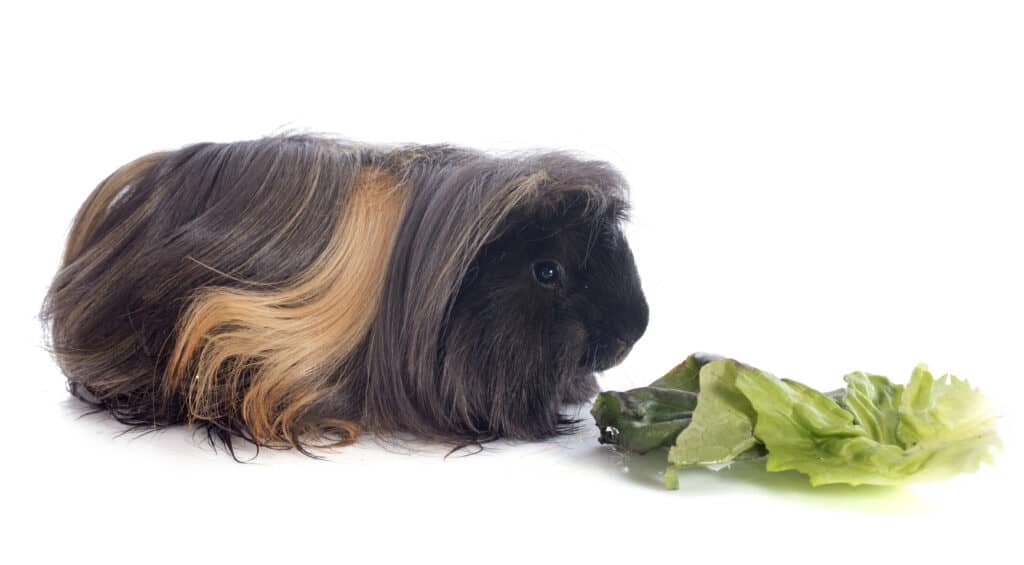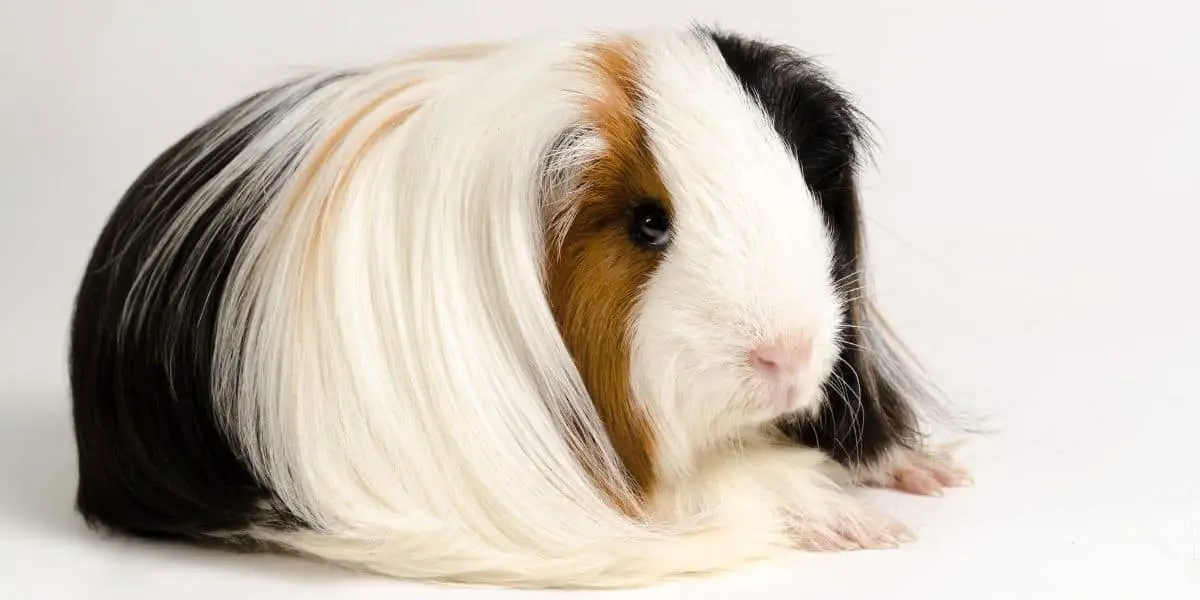The Peruvian guinea pig is best known for its extraordinary looks, namely its long, beautiful hair! Peruvian guinea pigs are gorgeous, sweet-tempered, and sociable. They also require lots of care to keep their long locks in check, however.
This makes the Peruvian guinea pig the perfect pet for someone experienced and/or responsible… but less so for a child or beginner!
Check out our review of the best Guinea Pig Cages here ↗️
Table of Contents
Temperament and Appearance
Peruvian guinea pigs are renowned for their long, glorious manes of hair, which are silky and thick. This hair can reach 12-14 inches in length, and grows from a part along their back. These manes highly attentive care. Peruvian guinea pigs grow 7-10 inches, rarely more.
The Peruvian Guinea Pig tends to be more curious and alert than most other guinea pig breeds and is notably braver. This breed is also quite docile, intelligent, interactive, and can even be very playful.
Peruvian Guinea Pigs make delightful pets for the right owner.

Grooming
Grooming a Peruvian Guinea Pig properly is absolutely key to their care. These guinea pigs depend almost entirely on their people to keep them brushed, washed, and hygienic overall. Otherwise, a deadly condition by the name of flystrike will swiftly become a risk.
To avoid this, you must brush your Peruvian Guinea Pig every single day and also do a once to twice-daily check and cleaning (bathing their lower half only) for soil. The cage should be cleaned daily, as well.
Lifespan
Most guinea pigs live from 5-8 years, while Peruvian Guinea Pigs can reach a whopping 12-14… impressive!
Cage
For one guinea pig, A cage should be no less than 7.5 square feet; for two or more guinea pigs, a cage should be 10 feet minimum, or (ideally) more.
When choosing a cage for any guinea pig, you will want bars that are closely-spaced and chew-proof. The best, most durable cages are typically made of metal (hard plastic can also be OK).
Set up this cage in a quiet area, safe from pets, small children, or the TV. Peruvian Guinea pigs are quite social and should still be visited often, however!
We highly recommend the Prevue Indoor Guinea Pig cage which is huge and is recommended by many Guinea Pig breeders and Societies around the world.
Bedding
Perhaps you have heard of some guinea pigs using bedding made of straw. As it turns out, this is not ideal for the Peruvian Guinea Pig, at all. The bits of straw will all-too-easily become tangled in their hair.
Instead, try pet store-bought aspen wood shavings (never from the lumberyard), or bedding made from paper. We have an article about alternative bedding options here. You may find it helpful.
Food and Water
It’s critical for the health and well-being of your Peruvian guinea pig that you provide them with the best possible diet and ensure they receive the vitamins and minerals they need to grow and live a long and happy life.
Must-Have Vitamin C
A little-known fact is that guinea pigs don’t actually produce their own vitamin C. They depend on what they eat entirely for this vitamin, which is essential.
This means that it is up to you to ensure that your guinea pig gets plenty of fresh produce full of vitamin C, and vitamin C-fortified pellets, as well. Otherwise, they’ll quickly develop scurvy, and become very sick.
We use Small Pets fortified Pellets available on Amazon ↗️
Vitamin C Treats are also available as a supplement.
Timothy Hay
Guinea pigs are grazing animals and should have unlimited access to their grass of choice. Timothy Hay is the most nutritious option available. This grass is perfect for the physiology of guinea pigs, being low-sugar yet high in fiber.
Chewing hay all day also keeps the constantly-growing teeth of guinea pigs in check. Your Peruvian Guinea pig should always have plenty of clean, fresh hay, 24/7.
Pellets
We advise that you supplement your guinea pig’s diet with pellets, as these are fortified with essential nutrients like protein, fiber, and vitamin C. They are also very healthy for guinea pigs to chew.

Fruits, veggies, and greens:
Your Peruvian Guinea Pigs should have fresh produce every day. Fruits, veggies, and greens are full of antioxidants and essential vitamins… including precious vitamin C! Some guinea pig-safe produce is listed below:
Fruits:
- Raspberries. Rich in antioxidants and vitamin C. Guinea pigs may have one raspberry, up to two times/week.
- Strawberries. Rich in antioxidants and vitamin C. Guinea pigs may have ⅓ strawberry, up to two times/week.
- Oranges. One of the top sources of vitamin C. 1-2 slices 2-3 times a week.
- Apple. Guinea pigs may have up to ½ cup of apples once to three times a week.
- even oranges are OK.
- Guinea pigs may also have blueberries, blackberries, peaches, and more (always check).
Veggies:
- Red and green bell pepper. One of the best sources of vitamin C for guinea pigs is bell pepper.
- Cucumber. Looking to hydrate your guinea pig in the summer? Offer them some water-rich cucumber.
- Broccoli. Safe in small portions (can otherwise cause uncomfortable gas).
- Also OK are properly-portioned carrots, cauliflower leaves, and more (always check).
Greens:
- Romaine lettuce. An excellent source of antioxidants, essential vitamins, and fiber.
- Red and green leaf lettuce. Red leaf lettuce is higher in antioxidants, and green leaf lettuce has more vitamin K.
- Guinea pigs may also have dandelion greens, carrot tops, cabbage, and more (always check).
Sociability
In the wild, guinea pigs would travel in herds, and they are a social animal still. Like most guinea pigs, Peruvian Guinea Pigs prefer to be kept in groupings of two or more. Just make sure that your guinea pigs are all the same gender, or mating will occur.
Peruvian Guinea Pigs more sociable than most guinea pigs when it comes to people, and petting and hand-feeding them is OK.
Exercise
All animals need their exercise, and the Peruvian Guinea Pig is no an exception to this rule! Make sure to let your Peruvian Guinea Pig outside of their cage once in a while, to stretch their legs, and explore!
Just make sure that the chosen room is suitably guinea pig-proof. This means free of houseplants (which are usually toxic), any cords they might chew, predatory pets, etc.
You can have low (in case they fall) ramps inside of your guinea pig’s cage, as well.
Final Thoughts
So, there you have it: everything to get you started caring for a Peruvian Guinea Pig of your own. All these showy guinea pigs really need are the basics are far as food and water, as well as some extra grooming, cleaning, and love!





